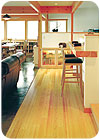

Photo courtesy of Teragren Fine Bamboo Flooring, Panels & Veneer, www.teragren.com.
Abundant harvest
Bamboo is the fastest growing plant on earth with some species growing up to four feet per day. Reaching maturity in three to five years rather than the 10 to 50 years required for most softwoods and hardwoods to mature, bamboo’s short growth cycle allows for a yield (weight per acreage) of up to 25 times higher than that of timber. Bamboo grows 33 percent faster than the fastest-growing tree. With only a three- to five-year growth cycle, a typical bamboo plantation realizes a return on investment in a very short period of time as compared to lumber. Since bamboo is self-regenerating, there is no need to replant after it is harvested, and it can be harvested selectively without any negative environmental impacts.Friend of the earth
Bamboo is a “pioneering plant” that can be grown in damaged soil. When harvested, the plant is not destroyed, so the topsoil is held in place rather than being disturbed. In newly planted areas with steep slopes, soil erosion can be a problem at first, but once the bamboo plant establishes itself, it is very effective at reducing erosion. That is why it is very often used in developing countries along riverbanks as a control against flooding and erosion. The dense litter dropped on forest floors by bamboo plants help, over time, to provide nutrients for topsoil.Because of its widespread root system and large canopy, bamboo absorbs twice as much water from the ground as trees, thus contributing tremendously to mitigating the problems caused by rainwater runoff. Bamboo also mitigates water pollution. Nutrients in the wastewater of manufacturing plants, sewage treatment facilities and livestock farming are absorbed by bamboo, which has a high capacity for nitrogen absorption. Bamboo, like trees, is a carbon sequester. That is, it absorbs carbon dioxide (CO2)-a greenhouse gas, and releases oxygen (O2) thus helping to maintain the balance of CO2 and O2 in the atmosphere. Some species of bamboo can sequester up to twelve tons of CO2 per hectacre.
Compared to an equivalent stand of trees, bamboo releases up to 35 percent more O2 in the same amount of time. Though wood stores more carbon than does bamboo, bamboo removes more carbon from the atmosphere because of its rapid growth cycle. All plants take in CO2 and convert the carbon into carbohydrates, which make up their structure. Thus, carbon is sequestered in all living plants and the many products made from them. When used to make long-enduring products, bamboo has the potential to sequester more carbon over time than any other agricultural land use. It is when decomposition and/or burning occurs that sequestered carbon in bamboo, trees and plants is released back into the atmosphere.
Friend of the people
Besides being a food source and building material for centuries, bamboo is held in high regard in all Asian cultures. In China alone, it has over 5,000 uses, including scaffolding for skyscrapers. I’ve personally been witness to this on a trip to Hong Kong in the late 1980s. I was amazed at the site of a 20-story building completely surrounded by bamboo poles formed into scaffolding. I inquired further and found out that, in Hong Kong, there is a special trade just for bamboo scaffolding that requires an apprenticeship leading to journeyman status-just like a carpenter or a mason.In Japan, clothing is made using bamboo fibers. The fabric has a texture like silk and accepts dyes of synthetic and natural colors equally well. Bamboo is also widely used as an herbal medicine. The roots and leaves are used to treat kidney disease, cancer and venereal disease. Sap (secretions) from bamboo is said to reduce fevers and is used for respiratory problems such as coughs and asthma. The ash of burned bamboo is rumored to cure prickly heat and when used as an aphrodisiac, your love life is likely to improve.
Moso Mo-Jo
As mentioned in Part One, moso bamboo is the most widely grown bamboo in the “Bamboo Sea” of Hunan province in southern China. There, it is grown as both a food and fiber source. Where bamboo plantations produce bamboo shoots for food, there is a greater likelihood of fertilizers and/or pesticides being used. Wealthy Chinese provinces use industrial fertilizers that are more environmentally friendly, emphasizing the nitrogen component. Poorer provinces still use the traditional method of spreading manure, human waste, food scraps, etc., on bamboo as fertilizer. Anywhere from 25 percent to 33 percent of all bamboo plantations in China use small amounts of pesticides for bamboo grown as a food source. However, use of pesticides is much lower for bamboo destined for uses other than human consumption.Many Chinese farmers have replaced their rice paddies, eucalyptus, pine and Chinese fir trees with bamboo plants because they are more profitable to grow. If not carefully managed, bamboo can, and will, invade forests and overwhelm them due to its aggressive nature. In the 1980s and ‘90s, little attention was paid to the environmental effects such as soil erosion and limited biodiversity with the changeover to so much bamboo being grown in lieu of other species. Fortunately or unfortunately, China’s agricultural industry is a very controlled environment and there are few virgin forests left, thus, the greater biodiversity that forests offer is not much of an issue in China. The greater problem is a tendency to over-harvest. Local governments in some regions of China pay farmers to harvest only mature (three-plus years) bamboo and encourage biodiversity and the avoidance of chemical treatments. If cut when immature, the following spring a pole of smaller size/diameter will appear (plus or minus one inch). Though it will eventually regenerate, it takes time to do so and clear-cut, immature bamboo is of limited value. Its only practical use is for making mulch for paper manufacture.
Depending upon whom you ask, some will say moso bamboo reaches maturity in just three years; others say five to six years. Visually, it’s hard to tell the difference. That’s why bamboo farmers track the culms (plant) carefully after the first year of growth-when the shoot has reached full size. At this point, the shoot is marked with the name of the owner and date. Other growers use electronic tags at the one-year point to identify the purchaser. Moso bamboo rises from the earth at its full diameter of eight inches. At this early stage, it is almost entirely water and sugar. This begins the culm’s liquefaction into hard cellulose.
Growing pains
Over the next two to five years, capillaries thicken toward the inside while the diameter remains constant at eight inches. This “hardening of the arteries” is what gives moso bamboo its great tensile and compressive strength at maturity. Immature bamboo tends to dent easily but actual hardness is most dependent on the age of the culm at the time of harvest and the species of bamboo.Bamboo scores in the range of 1,130 to 1,640 psi based on the Janka Ball Hardness Test (ASTM D1037). This rates bamboo as hard or harder than red oak (1,360 psi) with less dimensional change and a moisture content level that is less than most hardwoods. However, heating bamboo to provide a darker, amber color (a.k.a. “carmelization”) by pressure steaming reduces bamboo’s hardness by about 10 percent. Per the Janka Ball Hardness Test, natural un-carmelized bamboo scored 1,850 psi while caramelized bamboo scored 1,470 psi. The heat of the carmelization process softens the bamboo’s cellulose fibers, thus weakening them.
During the years of growth, the shoot is feeding the bamboo plant itself. By the third year, the shoot is no longer doing so and is, in fact, “dead-weight” to the plant. As such, removal of the shoot by harvesting it is actually beneficial to the plant. Conversely, premature harvesting of the shoot deprives the plant of its food source, to its detriment. This is why it is so important to harvest bamboo only when it has reached maturity.
Next month, we’ll conclude this series all about bamboo with a look at how bamboo is - and will be - used as a building material.



Report Abusive Comment